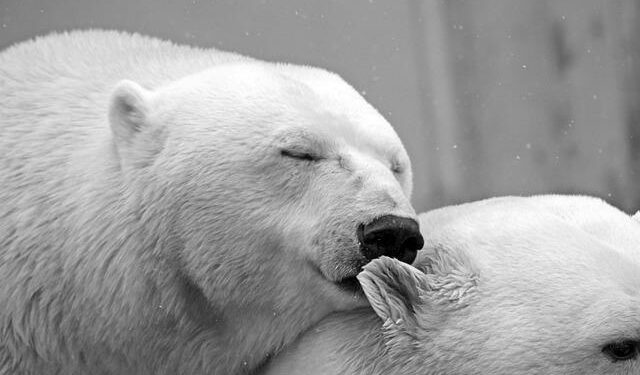Polar bears, often celebrated as iconic symbols of the Arctic wilderness, play a far more vital role in their ecosystem than previously understood. Recent research highlighted by EurekAlert! reveals that these apex predators are essential providers for a variety of Arctic species, supporting a complex web of life in one of the planet’s harshest environments. As climate change continues to disrupt the frozen north, understanding the interconnected relationships centered around polar bears is crucial for preserving the fragile balance of the Arctic ecosystem.
Polar Bears Support Arctic Ecosystem Stability Through Nutrient Redistribution
Far beyond their iconic status as apex predators, polar bears play an unexpected yet vital role in maintaining the delicate balance of the Arctic ecosystem. By hunting seals on sea ice and transporting prey remnants across various terrains, these majestic creatures facilitate the transfer of essential nutrients from marine to terrestrial environments. This nutrient redistribution enriches the soil and supports a range of Arctic flora and fauna, creating a subtle but critical web of life that sustains biodiversity in an otherwise harsh habitat.
Recent studies highlight several key processes through which polar bears influence ecological stability:
- Carcass provisioning: Leftover seal remains attract scavengers such as Arctic foxes and gulls, providing necessary sustenance during scarce periods.
- Soil enrichment: Nutrients from decomposing remains enhance tundra vegetation growth, supporting herbivores like hares and caribou.
- Microhabitat formation: Disturbance of ice and snow during hunts indirectly shapes small-scale habitats, influencing species distribution.
| Impact Area | Beneficiary Species | Effect |
|---|---|---|
| Carcass Remains | Arctic Fox, Glaucous Gull | Food source during lean seasons |
| Soil Nutrient Boost | Tundra Plants, Lemmings | Enhanced growth and population support |
| Ice Disturbance | Seal Pups, Snow Buntings | Microhabitat diversity increases |
Understanding the Role of Polar Bears in Sustaining Scavenger Populations
In the harsh Arctic environment, polar bears perform an indispensable ecological function far beyond their role as apex predators. When these majestic creatures hunt seals and other marine mammals, they inadvertently become vital sustenance providers for a diverse array of scavengers. Leftover carcasses from polar bear kills supply crucial nutrition to Arctic foxes, gulls, ravens, and even smaller mammals, enabling these species to survive in a landscape where food often comes at a premium. This interdependence highlights a delicate balance within the ecosystem, where the survival of scavenger populations is intricately linked to the hunting success of polar bears.
Key species benefiting from polar bear leftovers include:
- Arctic foxes, which rely heavily on leftover seal remains to endure long, resource-scarce winters
- Various seabird species like glaucous gulls, which feed on scraps and benefit from increased food availability during polar bear hunting seasons
- Smaller mammals such as ermine and lemmings, who scavenge scraps and contribute to nutrient cycling
| Species | Primary Benefit | Dependence Level |
|---|---|---|
| Arctic Fox | Carcass leftovers | High |
| Glaucous Gull | Food scraps | Medium |
| Ermine | Small scavenged portions | Low |
Conservation Strategies Urged to Protect Polar Bears and Preserve Arctic Biodiversity
As the Arctic ecosystem faces unprecedented threats from climate change, scientists and conservationists emphasize the urgency of implementing robust strategies to safeguard polar bears and the intricate web of life they support. Polar bears are more than iconic symbols of the Arctic; they play a pivotal role in maintaining ecological balance. By regulating seal populations and scavenging carcasses, they indirectly nourish a variety of scavenger species, thus enhancing biodiversity in one of the planet’s most fragile environments. Protecting these apex predators helps preserve the health of the entire ecosystem, which is increasingly vulnerable to melting sea ice and habitat fragmentation.
Conservation efforts now focus on multidisciplinary approaches combining habitat preservation, sustainable indigenous practices, and innovative wildlife tracking technologies. Key recommended actions include:
- Protecting critical sea ice habitats through marine spatial planning and legal safeguards
- Collaborating with indigenous communities to incorporate traditional knowledge and sustainable hunting practices
- Expanding climate monitoring systems to forecast habitat changes and facilitate rapid response
- Enhancing international cooperation for cross-border polar bear populations and research sharing
| Conservation Strategy | Benefit | Status |
|---|---|---|
| Sea Ice Habitat Protection | Preserves nesting and hunting grounds | In Progress |
| Indigenous Partnerships | Integrates local expertise and cultural heritage | Ongoing |
| Climate Monitoring Tech | Enables early intervention | Expanding |
| International Collaboration | Improves resource sharing and policy alignment | Developing |
Insights and Conclusions
As research continues to unveil the vital role polar bears play in sustaining Arctic ecosystems, their importance extends far beyond their iconic status. By acting as key providers for various species, polar bears help maintain the delicate balance of life in one of the planet’s most extreme environments. Protecting these apex predators is therefore not only essential for their survival but also for the health and resilience of the entire Arctic community. Ongoing conservation efforts and scientific monitoring remain critical as climate change threatens to disrupt these intricate ecological relationships, underscoring the urgent need for comprehensive strategies to safeguard the future of the Arctic.































